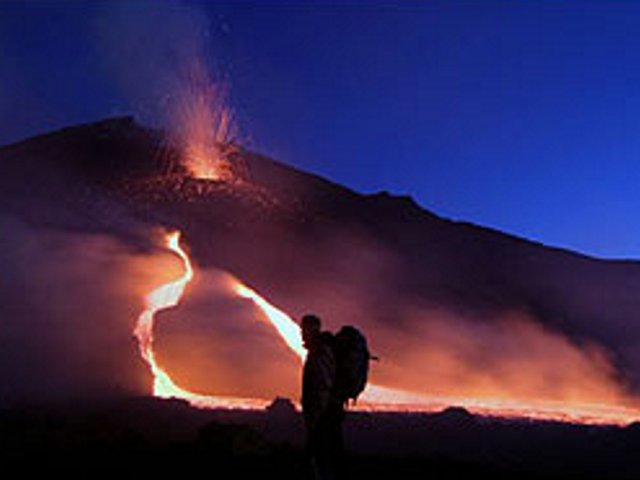Report on Etna (Italy) — July 2006
Bulletin of the Global Volcanism Network, vol. 31, no. 7 (July 2006)
Managing Editor: Richard Wunderman.
Etna (Italy) An upper E-flank fissure eruption lasting from 14 to 24 July 2006
Please cite this report as:
Global Volcanism Program, 2006. Report on Etna (Italy) (Wunderman, R., ed.). Bulletin of the Global Volcanism Network, 31:7. Smithsonian Institution. https://doi.org/10.5479/si.GVP.BGVN200607-211060
Etna
Italy
37.748°N, 14.999°E; summit elev. 3357 m
All times are local (unless otherwise noted)
This report covers the new eruption from an E-flank fissure during mid July 2006. Previously, on 7 September 2004, an eruptive period began that lasted until March 2005 (BGVN 29:09, 30:01). From March 2005 until November quiet degassing took place at the summit craters; on 16 December 2005 an explosive sequence at the summit was accompanied by an ash emission from the Bocca Nuova crater (BGVN 30:12). This report is from Sonia Calvari of the Istituto Nazionale di Geofisica e Vulcanologia (INGV) and covers the interval through 26 July. Brief mention is made at the end of the report about another episode starting on 31 August and going into at least mid-September.
On 14 July 2006 at 2330 a fissure opened on the E flank of the Southeast Crater (SEC) summit cone. Two vents along the fissure produced a lava flow spreading E to the Valle del Bove (figure 110). A helicopter survey carried out on 16 July at 0730 showed a braided lava flow field up to 1.7 km long. Based on the surface area and approximate volume of this lava flow field, workers estimated a mean output rate of ~ 2.6 m3/s during the first 32 hours of eruption. During the opening phase of the eruptive fissure, moderate strombolian emissions occurred at a third upper vent, located at about 3,100 m on the E flank of the SEC, just below the wide depression that cuts its eastern flank. It produced minor ash fallout on Catania. The composition of the ash was 80% juvenile, with small amount of lithics probably due to the opening phase of the vents.
On 17 July, the lava flow field was situated on the W wall of the Valle del Bove, and the two main flow fronts reached about 2,100 m elevation, spreading N of the Serra Giannicola Piccola ridge. The lava discharge peaked on 20 July (figure 111), when an effusion rate of ~ 10 m3/s drove the lava flow advance to a maximum distance of ~3 km within the Valle del Bove. The lava flow front widened at the base of Monte Centenari, at 1,800 m elevation, located at least 15 km from the closest villages. The effusion rate on 23 July decreased to ~3 m3/s. At that time the lava channels had narrowed and levees had partially collapsed. The eruption appeared to end on 24 July.
On 26 July, observers on the rim of the NE Crater heard strong explosions, and saw lapilli fall. This crater, together with the south pit within Bocca Nuova, showed significant thermal anomalies during a helicopter survey carried out on 24 July.
In the early morning of 31 August, Strombolian activity resumed at SEC's summit. In the next two weeks SEC was the scene of a series of dramatic events. By 11 September, lava from the SE flank of the SEC had advanced to reach ~3 km ESE. The resulting ribbon of lava was in places over 200 m wide. More details will follow in a subsequent report.
Geological Summary. Mount Etna, towering above Catania on the island of Sicily, has one of the world's longest documented records of volcanism, dating back to 1500 BCE. Historical lava flows of basaltic composition cover much of the surface of this massive volcano, whose edifice is the highest and most voluminous in Italy. The Mongibello stratovolcano, truncated by several small calderas, was constructed during the late Pleistocene and Holocene over an older shield volcano. The most prominent morphological feature of Etna is the Valle del Bove, a 5 x 10 km caldera open to the east. Two styles of eruptive activity typically occur, sometimes simultaneously. Persistent explosive eruptions, sometimes with minor lava emissions, take place from one or more summit craters. Flank vents, typically with higher effusion rates, are less frequently active and originate from fissures that open progressively downward from near the summit (usually accompanied by Strombolian eruptions at the upper end). Cinder cones are commonly constructed over the vents of lower-flank lava flows. Lava flows extend to the foot of the volcano on all sides and have reached the sea over a broad area on the SE flank.
Information Contacts: Sonia Calvari, Istituto Nazionale di Geofisica e Vulcanologia Sezione di Catania, Piazza Roma 2, 95123 Catania, Italy (URL: http://www.ct.ingv.it/); Reuters (URL: http://today.reuters.com/).



